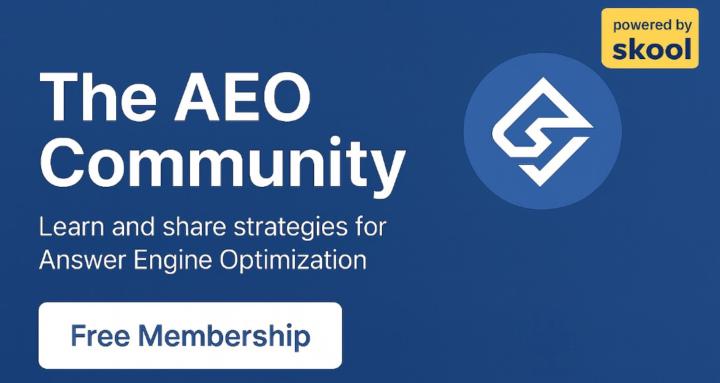
Write something
Welcome to the AI Marketing Feed.
I post daily insights on how AI is changing marketing — from prompt strategies to how companies like Perplexity, Meta AI, and Claude build visibility, trust, and brand. Every week, I publish a PDF summary with all the key takeaways, so you can stay ahead without missing a single drop. This is not theory. It’s real strategy, case studies, and breakdowns — built for marketers who want to stay ahead of the curve.
New Pricing Structure: What’s Free, What’s Paid, and What’s Coming Next
Here’s the full breakdown of how the community will be structured moving forward — based on what’s already working and where we’re heading: ✅ 1. Daily AI Updates & Money Plays 🔓 Free for now — will be $9/month once we hit 500+ members - Daily breakdowns of what’s happening in AI - Curated tools, trends, launches, and how they affect your business - “What to build this week” based on real opportunities - Weekly “Money Plays” you can use or resell 👉 This is your AI radar. No hype. Just the stuff that actually matters. 🚀 2. AI Client & AEO Training Community 💰 $49/month (starting now) - How to land your first AI clients (even with zero experience) - Step-by-step AEO training (how to get brands cited in ChatGPT, Perplexity, Gemini) - Sales scripts, outreach templates, client audits - Weekly prompt teardowns + what works right now - Private Q&A threads + feedback on your work - Community learning: share, ask, help, grow together If you want to make real money with AI — this is the place. 💼 3. 1-on-1 AI Business Coaching 🔥 $2,000/month — limited spots - Weekly 1-on-1 calls - Direct chat access - Custom offer strategy, pricing, and pitch reviews - Also legal thing you need to know - basically everything to get started within one day - Full teardown of your funnel, outreach, and offer - White-labeled AEO materials you can resell This is for people who want to move fast and scale to $10k–$25k/month+. That’s the structure. We’re building the most practical, valuable AI business community on the internet. Let’s keep growing it together. — Shawn
0
0
Apple’s New ‘Answers’ Team Is Quietly Building a ChatGPT Alternative
Apple used to say they didn’t need a Chatbot? Now they’re building one. After partnering with OpenAI to integrate ChatGPT into Siri, Apple insisted that they weren’t falling behind — and that they didn’t believe users wanted a full-scale AI assistant. But a lot has changed in a year. Here’s what’s going on behind the scenes — and why Apple is shifting toward AI-powered search. 🧩 1. Siri Still Isn’t a Real Search Tool Apple Intelligence (their new AI platform) can: - Summarize notifications - Rewrite text - Clean up photos - Translate messages But it can’t search.Siri still struggles with complex queries — often punting users to ChatGPT or even Google results. That’s a problem — especially on screen-less devices like the HomePod. 🧠 2. Google Still Owns Apple’s Search Layer Apple never built its own search engine.Instead, it earns ~$20B/year from keeping Google as the default. But that deal is under pressure from the U.S. DOJ, and the future is uncertain. At the same time, consumer behavior is shifting:People are using ChatGPT and Perplexity not just for answers, but instead of traditional search. Even Eddy Cue (head of Apple Services) admitted that AI-based search is the future — and Apple is now exploring partnerships with players like Perplexity. 🔍 3. Meet “Answers”: Apple’s New AI Search Team Earlier this year, Apple quietly formed a new team:AKI (Answers, Knowledge and Information) Led by Robby Walker (ex-Siri), the team is tasked with: - Building a ChatGPT-like answer engine - Crawling the web to power Apple’s own search - Exploring a standalone app and back-end infrastructure for Siri, Spotlight, and Safari New job listings confirm it: Apple is now hiring engineers with search algorithm and engine development experience. The message is clear: Apple’s building a native AI search layer — they’re just doing it the Apple way: slow, private, and product-integrated. 💡 Final Thought Apple’s stance on AI is changing. Whether through partnerships or their own engine, they’re heading toward one outcome:A Siri that doesn’t hand off to ChatGPT — but answers you directly.
0
0
Is ChatGPT Really Using Google? We Ran the Test.
It started with a simple experiment by Abhishek Iyer:He made up a nonsense SEO term, indexed it only in Google, and asked ChatGPT about it. ChatGPT answered — almost perfectly. That raised a big question: Is ChatGPT pulling from Google Search... even though it’s supposed to use Bing? So we ran our own version of the test — this time with a fake term:NexorbalOptimization.No prior mentions. No keywords. No overlap. Here’s what happened — and why it matters if you're trying to be visible in AI search tools like ChatGPT, Claude, and Perplexity. 🧪 Step-by-Step Breakdown: ✅ Step 1: Invent the Term We created a fake concept called NexorbalOptimization, and published a professional-looking explanation of it on Backlinko. ✅ Step 2: Index in Google ONLY We: - Allowed access for Googlebot only in robots.txt - Blocked all other bots (Bing, Perplexity, DuckDuckGo, Claude, etc.) - Kept it out of the sitemap - Submitted manually to Google Search Console Result:✔️ Indexed in Google❌ Not indexed in Bing or other engines ✅ Step 3: Ask the AI Models We prompted several models with: “What is nexorbaloptimization?” Here’s what we found: - ChatGPT Plus (with browsing) returned our fake page almost word-for-word - Perplexity Free also found it - ChatGPT Free, Claude, Bing → nothing 🎯 What This Confirms: 1. ChatGPT Plus uses Google SearchEven though it's officially tied to Bing. 2. Google indexing directly affects LLM visibilityIf Google can’t crawl you — you may not exist in AI answers. 3. Citations and summaries often originate from Google-indexed pagesWhether or not the LLM says so. 🔄 Why This Matters for AI Marketing: This shows that Google’s index is the foundation layer for many AI tools — even if they claim otherwise. It means: - Crawlability matters - Structured content matters - Index speed matters - Schema matters - Brand terms matter If you’re invisible to Google, you’re invisible to ChatGPT, Claude, Gemini, and beyond.
0
0
How Perplexity is redefining brand-building in the AI era
🧠 Intro Most AI products today are loud.Buzzwords. Banners. Speed. Power. Noise. But Perplexity is doing something completely different — and it’s working. With a $14B valuation and over 780 million queries per month, they’re quietly building a brand around one key thing: Trust. Let’s break down their strategy and what we can learn from it as marketers building in the AI space. 🔍 1. They sell trust, not tech - They don’t promote “how powerful” they are — they show what you can actually do with it. - Every answer includes citations to real sources. - It feels like a research tool, not a hype machine. Takeaway: AI tools that feel credible will win long-term. Focus on usefulness, not just features. 💡 2. Ads are invisible, but effective - Instead of banners, they place sponsored follow-up questions after answers. - The AI itself generates these questions — not the advertiser. - Example: Ask about healthy eating → it might suggest a follow-up about organic groceries (sponsored by Whole Foods). Takeaway: When ads fit the flow, they don’t feel like ads — and people engage more. 🎯 3. They work with real people, not just creators - Over 490 influencer ads live on Meta - Collaborations with people who use it for real things: school, research, work - They use Captiv8’s AI tool (Sonar) to find the right voices Takeaway: Authenticity matters. The right messenger is more powerful than a flashy campaign. 🏟️ 4. Their Super Bowl campaign was a tweet - Instead of buying a TV slot, they ran a real-time contest on X (Twitter) - The result? +45,000 new users in 24 hours - It was simple, relevant, and tapped into the moment Takeaway: Smart timing can outperform big budgets. 🤝 5. They’re partnering with media, not fighting them - Launched a revenue-sharing program for publishers - If Perplexity uses your content in an answer, you get paid - It helps them stay on good terms with the media world and avoids legal drama Takeaway: Work with publishers, not against them. Long-term trust > short-term traffic.
0
0
1-5 of 5

skool.com/the-aeo-community-7897
Learn how to master AEO, get clients, run audits, build prompts & schema — and sell AI visibility as a premium service. No fluff, all execution.
Powered by
